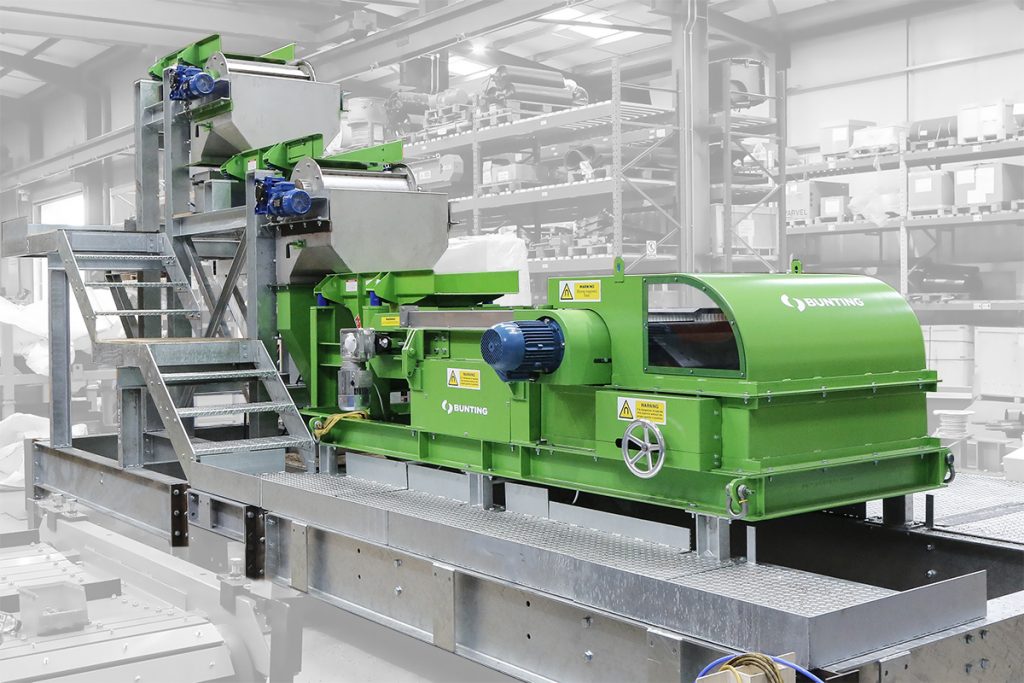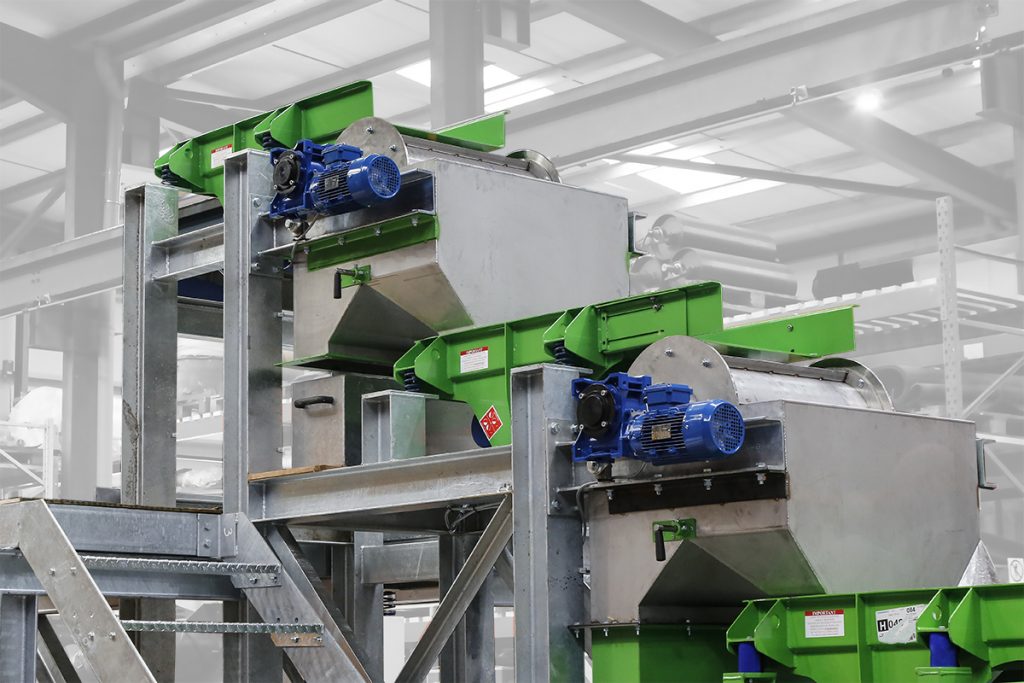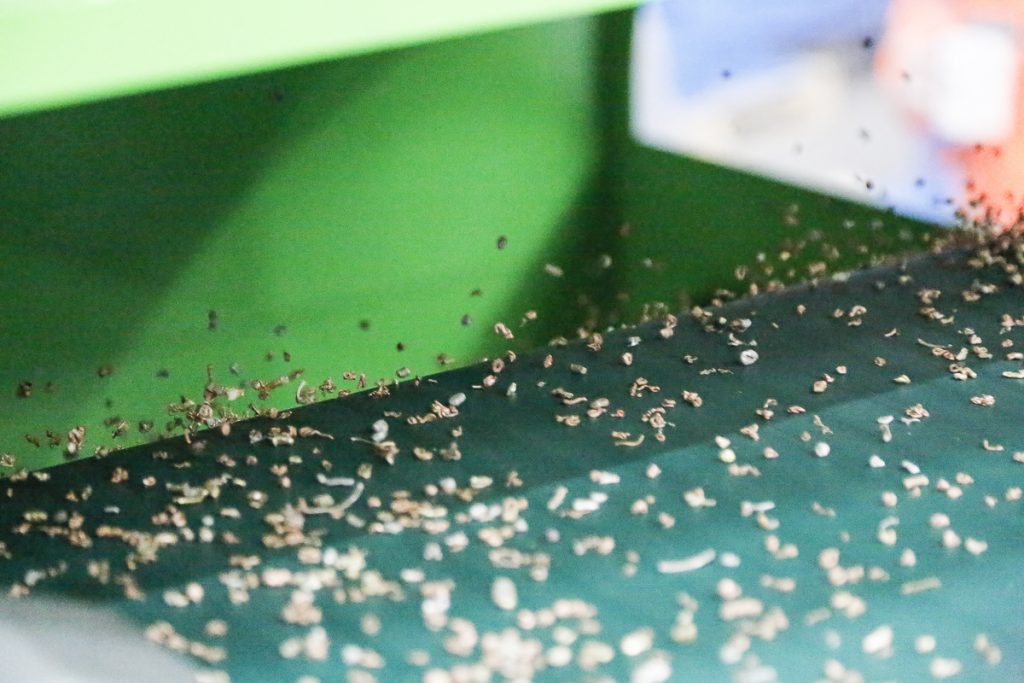Eddy Current Separator Pre-Shipment Material Tests
By Paul Fears | 19 July 2022
Although every Eddy Current Separator is fully mechanically tested prior to shipment, conducting material tests on a large triple-stage metal separation module complete with walkways and stairways was a challenge.

A significant area of the Bunting-Redditch shopfloor was allocated to the assembly of the Metal Separation Module, which included three Vibratory Feeders, two Drum Magnets, and one Eddy Current Separator. When installed on the customer’s site the whole frame would stand just under 6.2m high, although on the Redditch shopfloor, without connecting the base frame legs, the highest point was at 3.6m. The overall width was just under 4.6m. Once assembled and mechanically tested, the UK metal recycling customer visited our Redditch manufacturing plant to conduct some tests on the mixed metal to be processed on site.
Three-Stage Metal Separation
The Metal Separation Module includes standard and high-strength Drum Magnets, for ferrous and magnetic metal separation, and an Eddy Current Separator to recover non-ferrous metals. The three metal fractions are either sold or further processed.

Stage 1 – Ferrite Drum Magnet
The metal mix is loaded into the back end of the first Vibratory Feeder, which evenly feeds material onto the surface of a standard-strength Ferrite Drum Magnet. Strong magnetic metals such as steel are automatically removed.
Stage 2 – Rare Earth Drum Magnet
After the separation stage 1, the metal mix falls onto a second Vibratory Feeder feeding a high-strength Rare Earth Drum Magnet. The stronger magnetic field enables the separation of weakly magnetic particles, magnetic dust, and weakly magnetic shredded stainless steel.
Stage 3 – Eddy Current Separator
The metal mix is now free of magnetics and falls onto a third Vibratory Feeder which feeds the belt of the Eddy Current Separator. The belt of the Eddy Current Separator moves at a higher rate that the speed of the metal on the feeder tray, ensuring the material is well-spread as it moves into the separation zone.

A magnetic rotor mounted inside the non-metallic head pulley of the Eddy Current Separator and spinning at high-speeds induces an ‘eddy current’ into non-ferrous metal particles which causes them to propel away from the magnetic rotor. Due to the sub 3mm particle size of the metal mix, the Eddy Current had an eccentric rotor operating in the reverse direction.
Pre-Shipment Material Testing
Undertaking pre-shipment material tests on a fully assembled metal separation module is unusual and required careful planning. Areas within the manufacturing bay had to be cordoned off before assembling the module which included extensive surrounding framework of walkways and stairways. For safety reasons, the lower legs of the frame remaining unconnected.
The metal mix, stored in big bags, was lifted with a crane up to the top section of the module where the first Vibratory Feeder fed the Ferrite Drum Magnet. The material was then manually loaded onto the back of the feeder to pass through the three separation stages. Separate containers captured the fractions separated at each stage.
After each test, the quality of the end product reviewed and the set-up of the equipment adjusted as necessary. After several hours of tests, the customer approved the equipment.
“Undertaking pre-shipment material tests are always a challenge,” explained Adrian Coleman, General Manager of Bunting-Redditch. “We had to consider the safest methods of handling the metal mix material and raising it up to the highest level for introduction at stage 1. Also, the module was set-up on our main manufacturing shop floor, whilst we continued to build equipment for other customers. Congratulations to our team who did a great job in successfully and safely conducting the tests.”
Related Recycling Articles
For further information on Magnetic Separators, Eddy Current Separators, and ElectroStatic Separators for metal separation in recycling applications or to discuss a specific project including undertaking tests in our Customer Experience Centre, please contact our technical sales team on:
Email: Gordon Kerr at GKerr@buntingmagnetics.com
Telephone: +44 (0) 1527 65858
Photographs and video taken by Paul Fears Photography
Follow us on social media
